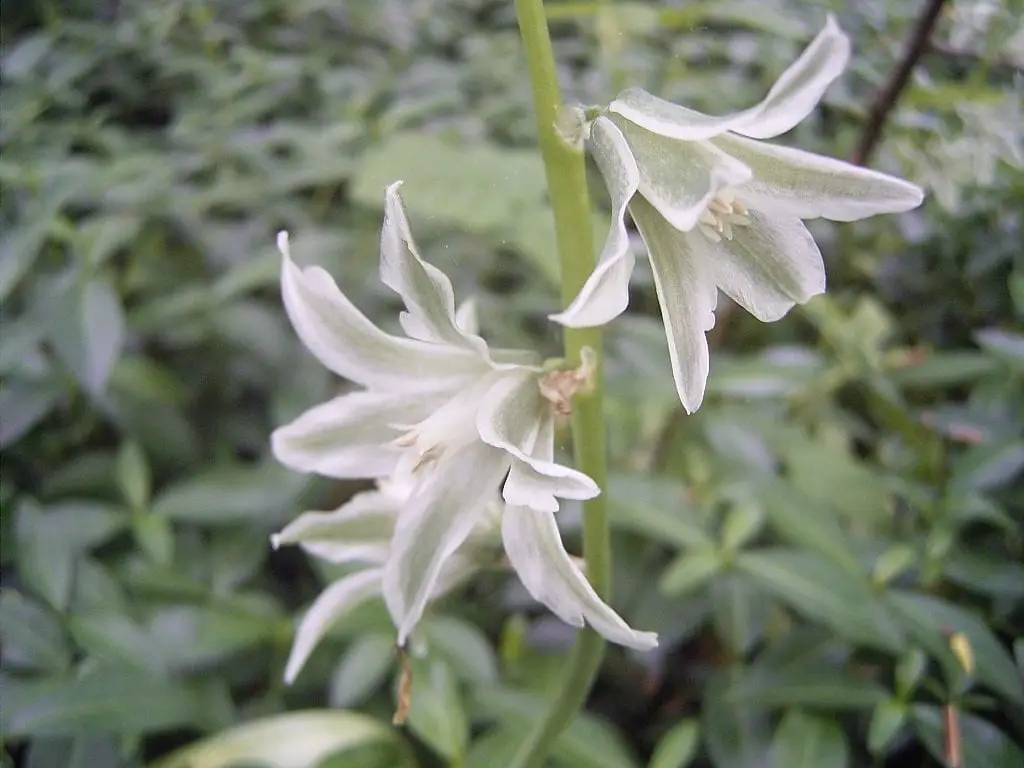
O. nodding. Image – Wikimedia / TeunSpaans
The Ornithogalum They are plants that, at first glance, do not seem to have a great ornamental value to say, but when the flowering season arrives you realize that they are a most interesting option to give a little color to the patio, balcony or terrace.
Although its flowers are rather small, they are very showy since they are also produced in large numbers. Do you want to know how they are cared for?
Origin and characteristics

O. arabicum. Image – Wikimedia Commons / Ghislain1
The Ornithogalum they are perennial bulbous plants that are distributed by Europe and southern Africa that are popularly known by the names ornithogalo or star of Bethlehem. Its bulbs are globose in shape, with white to light brown tunics. Linear or oblong-linear leaves sprout from them, and form a basal rosette. Leafless stems that can exceed 30 centimeters in height arise from the center, and flower clusters that measure between 30 and 50 cm or in loose corymbs sprout from the apex.
The flowers are hermaphroditicand are protected by a white bract (modified leaf). The fruit is a trilobed or triangular capsule inside which are globose to ovoid seeds.
The genus is made up of around 180 species, the following being the best known:
Ornithogalum doubt

It is native to South Africa. It reaches 50 centimeters in height -including the flower stalks-. Its flowers are orange and sprout in winter.
Ornithogalum umbellatum

It is native to central and southern Europe, northwestern Africa, and southwestern Asia. It reaches 60cm in height, or 30cm not including the flower stem. Produces white flowers in spring (April-May in hot regions of Europe).
What are their cares?
If you want to have a copy, we recommend that you provide it with the following care:
Location
The Ornithogalum is a bulbous that can be grown both indoors and outdoors, so the correct location will depend a lot on where you want to have it:
- Outdoor: it will grow well in semi-shade as long as that area is bright and / or where it can receive a minimum of 3 hours of direct light per day.
- Interior: it is advisable to put it in a room that is also bright, but not right in front of the window, otherwise its leaves could burn quickly.
Earth

Being rather small, whether it is grown in a pot or in the garden it will not cause problems. Now, this will be the case if the land provides what you need, so that there are no surprises we will put:
- Flower pot: universal growing medium (for sale here!) mixed with perlite in equal parts. For even better drainage, it is advisable to put a first 1-2cm thick layer of clay.
- the garden: fertile soil with very good drainage will do you good. In the event that it is compact and / or poor in nutrients, we will make a hole of about 40 x 40cm and fill it with the substrate mentioned above.
Irrigation
The frequency of irrigation will vary as the months go by. From the outset, you have to know that during the summer we will water much more often than the rest of the year, since moisture is lost faster. But it must also be borne in mind that it does not tolerate waterlogging, so that If we want to know when to water it, the ideal is to check the humidity of the soil or substrate. How do you do that? Well, very simple:
- With a simple thin stick of wood: we introduce it into the soil and if when we remove it we see that it comes out with a lot of soil attached, we will not water.
- Weighing the pot just watered and again after a few days: this way we will be able to know more or less how much the humid earth weighs and how much it dries.
- Using a digital moisture meter: as soon as it is inserted into the ground, it will tell us if it is wet or dry, but be careful, for it to be really useful it is important to introduce it again closer / further away from the plant. They sell it in nurseries, and also here!.
Subscriber
Throughout the flowering season (winter-spring) we will pay it with a fertilizer for bulbous plants following the indications specified on the package. In case of having the Ornithogalum in a pot, we will use liquid fertilizers; if it is on land we can use granulated or powder fertilizers.
Multiplication

Image – Flickr / Alfredo Eloisa
It multiplies by seeds in spring and bulbs in summer / fall. Let’s see how to proceed in each case:
Seeds
The step by step to follow is as follows:
- First, we will fill a seedbed (tray, glasses of yogurt, milk containers, … anything that is waterproof and that has or can have drainage holes) with universal culture substrate mixed with 30% perlite.
- Then, we water it conscientiously.
- Afterwards, we will place a maximum of two seeds in each socket / pot / container / etc.
- The next step is to cover them with a thin layer of substrate and water again, this time with a sprayer.
- Finally, we will place the seedbed outside, in semi-shade.
This way they will germinate in 2-3 weeks.
Bulbs
It is the fastest and most effective method. To do this, you just have to remove the plant from the pot, carefully separate the bulbs and plant these in individual pots or in other parts of the garden.
Rusticity
The Ornithogalum withstand the cold and frost of up to -3ºCalthough they live best in hot climates.
What do you think of these bulbous plants?

